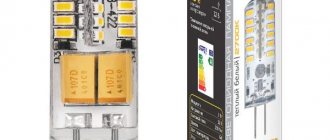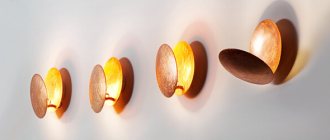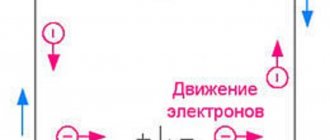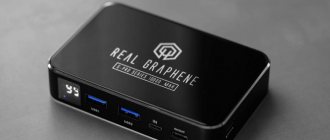Where is it used?
Size E27 can easily be called a household type of base. It is the most common due to its performance properties. Popularity has also affected availability; bases of this type are available from different companies, and you can buy them in the hardware department of any store.
Application area of E27:
- Residential premises (private houses, apartments).
- Utility premises (garages, basements, storage rooms, etc.).
- Small area production.
- Low power street lights.
Lamp for lamps with a diameter of 27mm.
A large percentage of light bulbs that people encounter every day in everyday life meet the E27 standard. Larger rooms require more powerful lighting fixtures.
Design Features
Different types of lamp bases have their own design characteristics, determined by the characteristics of production and application. Thus, the E27 base is an aluminum threaded element with a diameter of 27 mm. It is noteworthy that the letter “e” in the designation of types of lighting lamps refers us to the first letter of the surname of the inventor Edison. He developed and patented this type of base. The number "27" indicates the outer diameter of the thread.
The design of lamps of this type necessarily includes a glass bulb (or other housing), hook holders, current inputs, a fuse, an insulator and conductive contacts.
Advantages and disadvantages
When choosing a lighting scheme for their home, people often decide to use a standard E27 type socket. And this is not strange, because it has many advantages:
- Popularity . The main “competitor” for E27 today is E14, both sizes are available in almost every store. There is no need to order a rare type of light bulb online.
- Price . The mass nature of the product and inexpensive components make it accessible to everyone. Products with E27 socket are inexpensive.
- Range. Incandescent, LED, halogen and energy-saving models are sold with this base. Also, every manufacturer has E27, so you can choose a lighting device based on quality and cost.
The E27 size is available in most popular lamps. - Does not deform . The Edison base, including size 27, is a very durable structure, the shape of which is not affected by temperature changes or shaking during transportation.
- Power . With such a base there are devices even rated at 300-350 W, which is enough even for a relatively small production.
Flaws:
- Possibility of corrosion. If the base starts to rust in the lamp, it will not be easy to remove it later.
A rusty base can cause a lot of problems - There are low quality products. The range of lamps of this size is really large, there are even very low quality models from little-known manufacturers.
When buying a lamp, you need to take into account the conditions of its operation; for outdoor use it is better to take special moisture-resistant options.
Dimming
The word "dimming" comes from the English language. The verb "dimming" means "darkening." Dimming is the adjustment of the brightness of the light emitted by a lamp. Different types of luminaires require different dimming methods. The device for dimming is called a “dimmer”. With its help, the bright, invigorating light in the room can be changed to soft light. This will reduce energy costs and at the same time renew the atmosphere in the room.
The dimmer cuts off a piece of sinusoid from the voltage entering the device. Essentially, the dimmer turns the voltage going to the device on and off 100 times per second. An incandescent lamp and an LED fixture behave differently when passing through a dimmer. Thus, the LED lamp will continue to burn brightly, even if the incandescent lamp under the influence of the dimmer has almost gone out.
Not all devices can be dimmed, because a voltage stabilizer is installed in the E27 socket. An indication of the possibility of dimming the device must be recorded on the packaging or in the instructions. After dimming a light bulb that is not intended for this purpose, it will simply go out. If the manufacturer has not indicated the presence of such a technical capability, the device cannot be dimmed. For example, an E27 LED bulb must be equipped internally with a special circuit that recognizes dimming signals.
The dimmer for the lamp must be selected individually. Dimmers and light bulbs can have different maximum and minimum levels. For devices to operate correctly, their indicators must be compatible with each other. Dimmers for LED lamps should be set to the lowest possible minimum level.
Main features of the E27 base
The E27 base is really widespread and has many advantages. But you can recognize it among others primarily by its characteristic design and size.
Design
A glass or plastic flask can have almost any shape, but the base itself is a standard cylinder with a thread. It is with the help of this thread that it is screwed into the lamp socket.
Base with dismantled bulb.
The connecting part of the socket is made of metal or ceramic and has contacts that transmit electricity to the light bulb. There are electrodes on the base, they receive this electricity and transmit it further to the threads or board. An additional element in the design is a rod, its function is to pump out air.
Dimensions
It is almost impossible to determine the size of the connection from the light bulb itself. There are models with a small flask, 70 mm long and 45 mm in diameter, and there are also large options with 180 and 80 mm, respectively. There may also be narrow long lamps or short wide ones.
But the base itself has standard dimensions, as indicated by its name. The diameter is 27 mm, and the height is just shy of 26.67 mm.
Exact dimensions.
Energy saving
This is often the name given to small fluorescent light bulbs. These products have earned enormous popularity among the population of Russia and the whole world because they do not require a large amount of electrical energy to operate. They became very relevant when electricity prices became prohibitively high. And indeed, the counter practically does not rotate, and the light is very bright. E27 is a lamp that can be installed in any socket in a modern apartment. You can buy products at any hardware store or supermarket.
Using innovative technologies used in the production of light bulbs, these solutions are compact in size. There is a large selection of power and shapes available. What really remains the same with an energy-saving product is durability and efficiency. In order for the lamp to serve as long as possible, you should not turn it on in vain. It is believed that frequent on/off cycles reduce the service life of these products.
The advantage of this type
Compared to most other options, the main advantage of E27 is its prevalence. If a light bulb fails, it is easy to find in stores in the city. Replacement will also not be a problem, you just need to turn off the light, unscrew the old lamp along the thread and screw on the new one.
The process of replacing a light bulb.
How to disassemble an e27 LED lamp
Disassembling an LED light source is not difficult even for a novice electrical engineer. The main thing is to arm yourself with the necessary tools.
LED design
You will need an awl, a syringe with a needle and a solvent (for paints; not acetone). Pour the solvent into the syringe. Carefully run an awl along the edge of the diffuser in the place where it is attached to the radiator. Pour solvent little by little from the syringe into the well. Wait 5 minutes: during this time, the solvent will soften the sealant that glues the diffuser. Then carefully rotate the diffuser and remove it.
If the diffuser is not glued to anything, then simply twist it and remove it.
If the diffuser is attached with latches, then with an awl, moving around the circle, it is enough to pry up the diffuser and find the places of the latches. After this, you can easily bend them with an awl (or a sharp knife) and remove the diffuser.
After removing the diffuser, all that remains is to unscrew the screws from the board with LEDs with a screwdriver, remove the board and remove the driver. If there are no screws, then the board is glued with sealant. It is enough to cut it with an awl around the circumference and remove the board by prying it with a knife.
Types of lamps with E27 base, their features
Lamps differ in operating principle and performance characteristics. Each type is also presented under the E27 label.
Incandescent lamps
The device of a standard incandescent light bulb.
The oldest version of lighting lamps, it was for them that the E27 base was developed, so this size is most often installed in incandescent lamps. As for the technical characteristics, the power ranges from 15 to 250 W, and the luminous flux is about 10 Lm/W.
Advantages:
- low price;
- even light;
- not afraid of moisture;
- simple design.
Minuses:
- high energy consumption;
- short service life;
- fragility of the flask;
- heat.
Read more about the characteristics and types of incandescent lamps here.
Halogen
Halogen lamp device.
The operating principle is similar to incandescent lamps, but additionally halogen vapors enter the bulb. This increases the luminous flux, which reaches 17-20 Lm/W. For halogen models, a base marked G is more often used.
Advantages:
- work at different temperatures;
- not afraid of moisture;
- good and uniform light;
- price.
Flaws:
- requirements for stable voltage;
- high power consumption;
- You can only touch them with gloves.
Halogen
E27 halogen lamps have the same threaded base. They are easily installed in traditional sockets, which are found in every apartment. These models are made using a different technology, and their service life differs significantly from their analogues. By the way, incandescent lamps are also popular due to their price-quality ratio. Halogen products can burn for 4000 hours. As for the color rendering indices in the luminous flux, it is equal to 100%.
The technological processes for producing halogen lamps contain some iodine or bromine. These ingredients help to get better light output. It corresponds to 20-30 lumens per watt. At the same time, such a high level of light output will remain throughout the entire service life of the product. Such elements, unlike incandescent lamps, are manufactured in smaller sizes. The form can be varied. There are many ways to use such products.
In which lamps are they used?
Lamps with E27 socket are used for household and industrial lighting. They are suitable for table, wall, and pendant lamps. Size E14 is also used in low and medium power lighting fixtures, including various lamps and sconces. For powerful outdoor lighting, E40 lamps are used; they have a power of up to 2000 W.
Main dimensions of lamps.
Compatible with other sizes
The connection of the base allows, if necessary, to replace the part or carry out repair work. This option is not directly compatible with others, but the problem can be solved by using special adapters.
Application of base adapters
When you need to insert a lamp into a socket that is not intended for it, you can use special adapters. They simply allow you to go, for example, from size E14 to E27 without losing power or any other qualities.
But there is also a drawback - the length of the structure, which is not always convenient. If the light bulb protrudes strongly from the shade, this negatively affects the appearance of the lamp, and also increases the risk that the light bulb can be accidentally touched and broken. Therefore, the use of adapters is not always advisable.
Base adapter from 14 to 27 mm.
As for the range of adapters, there will be no problems. They are presented in an assortment in lighting stores, and the required adapter can also be ordered online. Adapters are produced by Cosmos, OBI, Lemanso, E.Next and dozens of others. There are even models for combining different types of bases, for example from G9 to E27 or vice versa. Dual type models are available; two lamp sockets can be output from one input. The cost starts from ten rubles and can reach several hundred.
Features of the device and operation
The operating principle of lighting elements based on diodes is to convert energy: electrical into light equivalent. The design is based on an LED, which is a semiconductor device. An E27 light bulb can contain a different number of such elements: from several pieces to several dozen.
Much depends on the power: the higher the value of this parameter, the more diodes will be required. For example, the 15W and 20W versions contain much more emitters (from 60 pcs.), and the design with a 10W load provides 42 diodes.
Different manufacturers (Osram, Navigator, etc.) are trying to improve their products, but in general the design of an E27 diode lamp with an input voltage of 220V is similar: a base, a driver, a number of emitters, a radiator and a diffuser.
Diode lamp design
The last of these elements is not always used; for example, the E27 220V light source of the “corn” type does not contain a diffuser. The function of the driver is to stabilize the current, which allows you to install the lamp in a socket under the E27 socket and connect it to a 220V network. The radiator is a metal element with a large number of fins.
This design allows you to increase the cooling area:
Light source power circuit
The 0.2 µF capacitor is called ballast and does not allow the current flowing through the LEDs to exceed 25 mA. The diode bridge VD1-VD4 performs the function of a voltage rectifier. Another element, a 10 µF capacitor, smoothes out the ripples of the rectified voltage. The circuit also uses limiting resistors.










